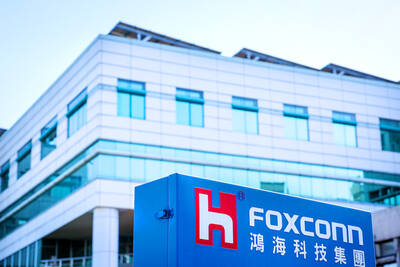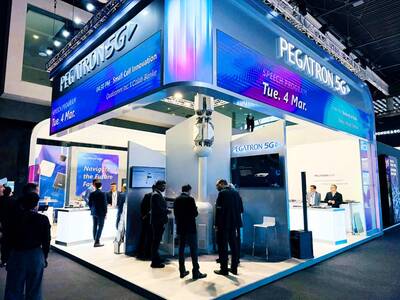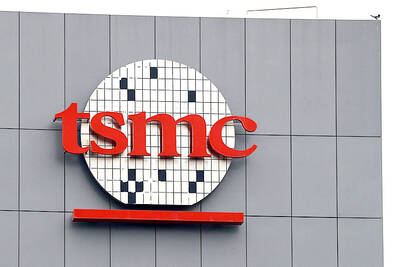MediaTek Inc (聯發科) yesterday said that its first-quarter profit almost halved year-on-year, citing softer-than-expected mobile phone demand and supply chain inventory corrections that curbed customers’ orders for its chips.
MediaTek, one of the world’s biggest mobile phone chip suppliers, said net profit for the first three months of the year plummeted 49.3 percent to NT$16.87 billion (US$548.8 million), the lowest level in about nine quarters. Net profit was down from NT$33.26 billion in the first quarter of last year. On a quarterly basis, net profit contracted 8.7 percent from NT$18.49 billion.
Gross margin last quarter dropped to 48 percent from 48.3 percent in the previous quarter and 50.3 percent in the first quarter of last year, largely because of weaker pricing for certain models, the company said.

Photo: Vanessa Cho, Taipei Times
MediaTek said some of its major customers have reduced excessive inventory to a normal level, but they hold a prudent view about mobile phone demand in the near term.
As a result, MediaTek expects revenue from its mobile phone chips business to be flat this quarter on a sequential basis after plunging 20 percent quarter-on-quarter last quarter.
The company expects a pickup in the second half of this year, although it said that the overall business visibility remained vague.
Mobile phone chips accounted for 46 percent of the company’s total revenue of NT$95.65 billion last quarter.
Revenue this quarter is expected to dip 4 percent sequentially to NT$91.8 billion in the chip designer’s worst-case scenario, while its best-case scenario involves quarterly growth of 4 percent to NT$99.5 billion.
The company told investors three months ago that the first quarter was “likely a low point” of this year.
“We believe customer and channel inventory is coming down. We just had discussions with major OEM [original equipment manufacturing] customers. Their inventories have come down to levels they deem normal. Some others are still a bit higher. Overall, inventory has been coming down from the end of the fourth quarter,” MediaTek CEO Rick Tsai (蔡力行) told investors in an online investors’ conference yesterday.
“The market sentiment remains weak. Customers are drawing shipments cautiously even when their inventory has normalized,” he said.
The company said its second-quarter guidance reflected customers’ cautious outlook about market demand and its strategies in a competitive environment.
With economic uncertainty increasing worldwide, consumers became more willing to buy refurbished smartphones, or second-hand handsets, rather than a new one, the chip designer said.
A longer smartphone replacement cycle is also affecting handset demand, it said.
Global mobile phone shipments would drop to 1.1 billion units this year from 1.4 billion units last year, MediaTek said, adding that the overall share of 5G smartphones would reach 55 percent.
MediaTek said that in the expected weak demand environment, it would remain consistent with its strategy that it seeks to balance its market share, revenue and profitability, rather than focusing only on price competition.
The “race to the bottom” type of pricing does not lead to higher end-market demand, nor can it change the overall market share distribution, Tsai said.
Demand for chips used in TVs and broadband devices, especially from North American telecoms, is showing robust momentum this quarter, the company said.
Chips used in smart-edge devices made up 47 percent of MediaTek’s total revenue last quarter.
Demand for power management chips, which contributed 7 percent to its revenue last quarter, would be stable this quarter, the company said.

Hon Hai Precision Industry Co (鴻海精密) yesterday said that its research institute has launched its first advanced artificial intelligence (AI) large language model (LLM) using traditional Chinese, with technology assistance from Nvidia Corp. Hon Hai, also known as Foxconn Technology Group (富士康科技集團), said the LLM, FoxBrain, is expected to improve its data analysis capabilities for smart manufacturing, and electric vehicle and smart city development. An LLM is a type of AI trained on vast amounts of text data and uses deep learning techniques, particularly neural networks, to process and generate language. They are essential for building and improving AI-powered servers. Nvidia provided assistance

STILL HOPEFUL: Delayed payment of NT$5.35 billion from an Indian server client sent its earnings plunging last year, but the firm expects a gradual pickup ahead Asustek Computer Inc (華碩), the world’s No. 5 PC vendor, yesterday reported an 87 percent slump in net profit for last year, dragged by a massive overdue payment from an Indian cloud service provider. The Indian customer has delayed payment totaling NT$5.35 billion (US$162.7 million), Asustek chief financial officer Nick Wu (吳長榮) told an online earnings conference. Asustek shipped servers to India between April and June last year. The customer told Asustek that it is launching multiple fundraising projects and expected to repay the debt in the short term, Wu said. The Indian customer accounted for less than 10 percent to Asustek’s

‘DECENT RESULTS’: The company said it is confident thanks to an improving world economy and uptakes in new wireless and AI technologies, despite US uncertainty Pegatron Corp (和碩) yesterday said it plans to build a new server manufacturing factory in the US this year to address US President Donald Trump’s new tariff policy. That would be the second server production base for Pegatron in addition to the existing facilities in Taoyuan, the iPhone assembler said. Servers are one of the new businesses Pegatron has explored in recent years to develop a more balanced product lineup. “We aim to provide our services from a location in the vicinity of our customers,” Pegatron president and chief executive officer Gary Cheng (鄭光治) told an online earnings conference yesterday. “We

LEAK SOURCE? There would be concern over the possibility of tech leaks if TSMC were to form a joint venture to operate Intel’s factories, an analyst said Taiwan Semiconductor Manufacturing Co (TSMC, 台積電) yesterday stayed mum after a report said that the chipmaker has pitched chip designers Nvidia Corp, Advanced Micro Devices Inc and Broadcom Inc about taking a stake in a joint venture to operate Intel Corp’s factories. Industry sources told the Central News Agency (CNA) that the possibility of TSMC proposing to operate Intel’s wafer fabs is low, as the Taiwanese chipmaker has always focused on its core business. There is also concern over possible technology leaks if TSMC were to form a joint venture to operate Intel’s factories, Concord Securities Co (康和證券) analyst Kerry Huang (黃志祺)